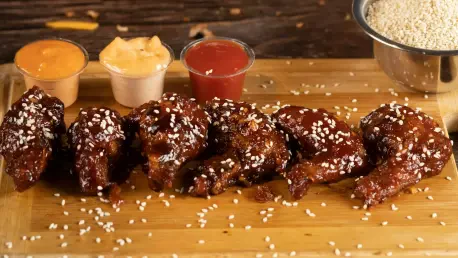A day dedicated to celebrating the beloved chicken wing, National Chicken Wing Day on July 29 has become a notable event in American culinary culture. With origins in Buffalo, New York, chicken wings have transformed from a regional delight into a nationwide sensation, now embraced by restaurant chains across the United States. This roundup offers insights from various culinary experts and industry participants on how restaurants use this celebration to showcase both classic flavors and innovative sauce and flavor combinations.
Evolution of Chicken Wing Day
Chicken Wing Day has evolved significantly since its inception. From humble beginnings in Buffalo, New York, the event now boasts widespread popularity and cultural significance. Experts in food history highlight the unique journey of chicken wings from being a local appetizer to becoming an essential component of American gastronomy. The transformation from simple frying techniques to today’s elaborate flavor profiles illustrates culinary expansion influenced by changing consumer tastes and dietary preferences.
Culinary Impact of Chicken Wings
Industry specialists recognize the impact chicken wings have on American cuisine, regarding them as a symbol of the fusion of simplicity and variety. While chicken wings have retained their traditional standing, many eateries are now experimenting with global influences. The day serves as a platform for restaurants to present both classic and new interpretations, offering flavors from diverse culinary traditions. This has led to the introduction of innovative options like cauliflower wings, merging traditional recipes with contemporary alternatives.
Diverse Sauce and Flavor Trends
Flourishing Creativity in Sauces
Restaurant chefs and culinary innovators agree that the rise of creative sauce options has led to more sophisticated chicken wing offerings. This trend reflects a deeper exploration of flavors, catering to the evolving palate of the American diner. As sauces become more diverse, consumers enjoy a broader spectrum of tastes, including sweet, spicy, and tangy profiles. The integration of unexpected ingredients into sauces and dressings represents a shift toward culinary experimentation and innovation.
Popular Trends and Selections
Recent data reveals the growing popularity of bold and innovative sauces. Restaurants have tapped into consumer demand by crafting and promoting themed sauces that invigorate traditional wings. Experts in consumer behavior note that choices such as Korean-style and peach-flavored sauces demonstrate a shift toward unexpected flavor combinations. These trends underscore the ongoing fusion of traditional and contemporary aspects within the culinary scene, with restaurant patrons eager to experience fresh and enticing options.
Balancing Tradition and Novelty
Food industry leaders outline the challenge of balancing tradition with innovation as culinary trends continue to evolve. While classic flavors and cooking methods remain popular, there is an evident demand for modern twists and creative approaches. Culinary pioneers emphasize the importance of remaining true to traditional recipes while actively incorporating novel ideas. This dynamic balance ensures that restaurants cater to both traditionalists and seekers of culinary adventure.
Expanding Influence of Global Flavors
Global Influence on Wings
The incorporation of international flavors into chicken wing recipes marks a significant shift in culinary approaches. Exploring influences from various global cuisines has transformed the classic wing experience, leading to unique taste sensations and style modifications. Culinary experts concur that this international infusion enhances the overall appeal and diversity of chicken wing offerings, inspiring chefs to push boundaries and experiment with flavors beyond traditional expectations.
Case Studies from Innovative Eateries
Inventive eateries across the nation have showcased their attempts to redefine and enrich the wing experience. Case studies of these establishments exhibit how specific strategies enhance creativity and flavor diversity. By implementing dynamic menu adaptations, these eateries not only attract a wider clientele but also shape culinary trends that resonate with adventurous diners. Observations in this sector highlight the need for continuous adaptation to meet consumer demands and remain relevant in an ever-evolving market.
Opportunities and Challenges in Flavor Expansion
Industry advisers highlight the opportunities for increased flavor experimentation while also recognizing competitive pressures. The market offers ample possibilities for enhancing offerings and satisfying consumer curiosity, yet it involves navigating novelty and risk. Strategically incorporating new ingredients and flavors can differentiate a restaurant, but it requires managing potential inconsistencies in consumer reception. Industry specialists advise maintaining a flexible approach to trial and error to pave the way for successful adoption of novel flavors.
Future of Flavor Innovation
Emerging Trends for Sauces
Forecasting the future of flavor innovation unveils emerging sauce trends and anticipated developments. Culinary experts speculate on continuous exploration of new combinations and the introduction of exotic ingredients with distinct taste profiles. Continued experimentation in sauces supports the restaurant industry’s drive for progress and differentiation, with each innovation opening doors for enhanced flavor experiences.
Regional Preferences
An exploration of regional taste preferences reveals varying demands across different parts of the country. Industry analysts recognize these regional differences as instrumental in determining which flavors are favored and trending. Restaurants capture this diversity by crafting region-specific recipes, creating a mosaic of culinary delights tailored to local tastes.
Surprise Contrasts and New Possibilities
Discovering surprising contrasts and possibilities within flavor profiles emphasizes the ingenuity and curiosity intrinsic to culinary evolution. Food enthusiasts anticipate the uncovering of unexpected relationships between flavors, leading to delightful combinations that defy conventional tastes and consumer expectations. Restaurants continue to rise to the challenge of charting these flavor landscapes, offering fresh experiences that surprise and tantalize the palate.
Community and Social Engagement
Beyond Culinary Trends
National Chicken Wing Day extends beyond culinary indulgence; it involves social and community engagement that enriches the dining experience. Community leaders acknowledge the day’s role in fostering environments where friends and families gather and share in celebrations. The social aspect of sharing wings and experimenting with flavors creates a sense of camaraderie and excitement while reinforcing their status as a communal dish.
Insights from Culinary Innovators
Industry insiders share valuable insights on the integration of creative ideas within restaurant offerings. Effective strategies entail crafting engaging dining experiences that resonate with both local guests and community ethos. By remaining attuned to consumer interests and investing in novel developments, restaurants maintain their standing as culinary innovators, primed to meet evolving demands.
Sustainability and Flavor’s Evolution
Considerations for sustainable practices in flavor evolution emphasize the importance of mindful sourcing and preparation techniques. Experts in sustainability advocate for responsible practices that ensure long-term flavor innovation without compromising environmental impact. Future considerations in flavor development incorporate these insights, offering paths for growth that align with principles of sustainability and culinary creativity.
Key Insights and Recommendations
Concluding observations emphasize insights gleaned from flavor explorations and sauce innovations. Restaurants are encouraged to drive engagement through interesting flavor combinations and community involvement. Strategies for customer interaction include leveraging digital platforms to amplify offerings, rewarding loyalty through personalized promotions, and minimizing environmental footprints while fostering culinary creativity. Consumers are motivated to enhance their dining journeys by exploring adventurous flavors, supporting local eateries, and participating in culinary events that celebrate the rich diversity of chicken wing offerings.









